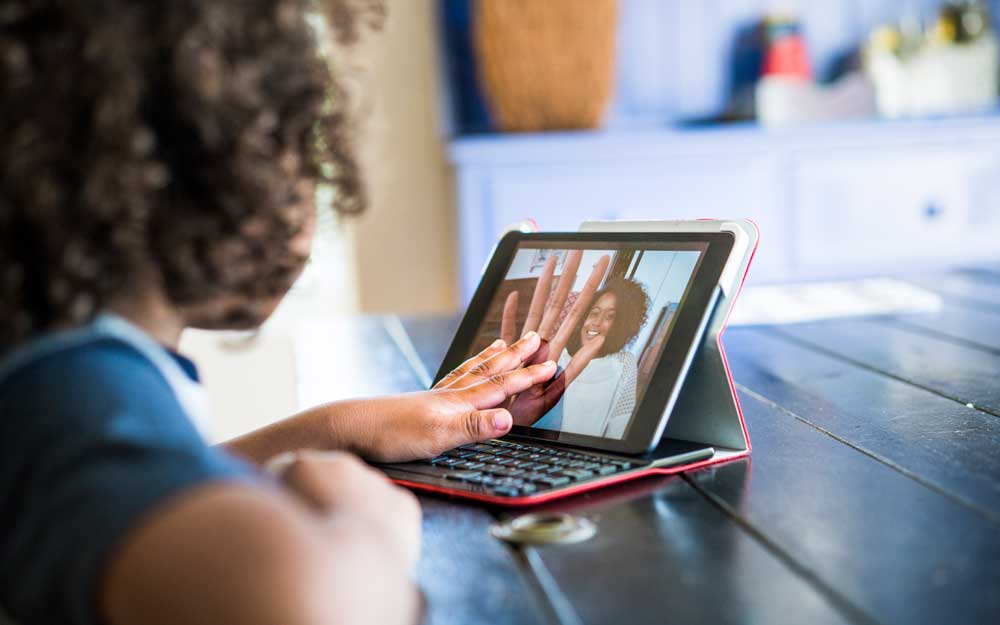Too much screen time can have a negative effect on mental health. However, during the COVID-19 crisis when social distancing and isolation are necessary, we are being asked to intentionally avoid having the same level of in-person interaction that is normally considered positive.
Even while screens and technology become more essential to our daily lives and communication, there are ways to use screen time in a healthier way. Elizabeth Hamlin, MD, medical director of Eating Disorder Recovery adult inpatient care, shares a few ways we can use technology to connect with others and still explore the world.
1. Video chatting and Facetime
One way to use screen time during the COVID-19 crisis that has gotten a lot of attention already is using video chat apps like Facetime, Skype, or Zoom to chat with family and friends.
“Even a Facetime conversation while having a cup of coffee with a friend can be greatly beneficial,” Dr. Hamlin says.
While online interaction isn’t as ideal as in person, Dr. Hamlin says that seeing someone’s face and their reactions provides an additional benefit that you don’t get from just hearing someone’s voice. “Even if it’s the second-best thing to seeing people in real time, we need to accept second best right now.”
She adds that for kids, seeing their friends, teachers, or older family members through a screen can help add more normalcy to their life.
2. Experiencing culture
With social distancing and many states following orders to stay home, cultural entertainment options are limited to what you can find within your own home. However, due to the pandemic, Dr. Hamlin says she has seen an “outflow of culture being available online for people to experience.”
Artists and symphonies are live streaming concerts for people to attend virtually. Museums, art galleries, zoos, and national parks are now open to virtual attendees. Many religious institutions have started livestreaming their services as well.
3. Education
Education through screens is one area that children and teenagers are already familiar with, as most schools have moved to providing their lessons through technology while buildings are closed. But Dr. Hamlin says there are educational offerings for people of all ages, such as coding classes, apps for learning a language, and myriad tutorial videos on YouTube.
“People may find themselves with more free time than they’ve had in the past, which gives them an opportunity to do something that they’ve wanted to do but previously didn’t have time for,” Dr. Hamlin adds.
4. Working out with screens
Another area where you may not have thought to use screens is for workouts or just everyday physical activity. If you miss a friend or family member, you could video chat while simultaneously taking a walk. Some gyms have moved to offering virtual workouts as well to adapt to social distancing. Otherwise, YouTube also has a plethora of available workout and yoga videos – many of which don’t require any special equipment.
“If there are no medical reasons to avoid exercise, movement can help boost moods or lower anxiety,” says Dr. Hamlin. “But like all other tools, it’s important to use exercise and movement only as a part of your overall coping strategies, not as the only way you cope.”
5. Relaxing without avoiding
Not all screen usage needs to be educational and it’s also important to make room for relaxation and fun. One thing to keep in mind while using screens during times of social distancing is that you’re utilizing technology to relax but not avoid doing something else. You can watch an episode or two of your favorite comedy, but Dr. Hamlin says to avoid marathon sessions where you watch for hours. On the other side of the coin, she also advises to avoid staying plugged into the news to the point where that’s all you are doing.
“Consuming all the news out there doesn’t help people feel better. Don’t completely avoid it, but there is an endless stream of information that you can access that may make yourself feel worse.”
Watching a video, movie, or TV show is a passive way to relax, but there are options that are more actively engaging, such as playing a game like Minecraft or Roblox. These kinds of games have the benefit of being about creating things and promote creativity. They can also be turned into a group activity and a way for kids to stay connected with their friends through online play.
Rogers can help
If you or a loved one are struggling with mental health symptoms, Rogers can help by providing evidence-based treatment for adults, adolescents, and children. Call 800-767-4411 or request a free, confidential screening online.


